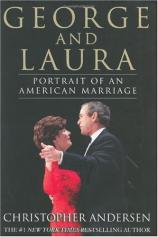George and Laura: Portrait of an American Marriage
Review
George and Laura: Portrait of an American Marriage
I suppose it is indicative of the times that we live in that the
marriage of President George W. Bush and the First Lady is the
subject of a book less than two years after they moved into the
White House. However, it is refreshing to look at a solid
partnership like this one after the endless tales that were news
fodder with the previous First Couple.
There are no great surprises in GEORGE AND LAURA. The drama of the
administration immediately preceding this one --- mysteriously
convenient deaths, defensive secrets transferred to enemies of this
country, the clandestine rendezvous with interns on the
Presidential Seal --- is gone. George and Laura Bush are...boring.
The most interesting tidbit in GEORGE AND LAURA is that George,
during his misspent youth, served as a dinner escort for...Tricia
Nixon.
Sure there was tragedy in both of their pasts --- the death of his
sister and the accidental death of her friend, but none of this is
news to most readers. And yes, the background on each of their
families that opens the book succinctly fills in gaps for anyone
who has not studied their world, but none of what we read is
earth-shattering revelation.
To his credit, Andersen tries to liven things up; the tales told in
GEORGE AND LAURA would be far less interesting in the hands of a
lesser writer. But there's not much in the way of explosions,
karate, and ripped bodices here. Yes the First Couple has trouble
with their teenage daughters, but to anyone with a teenager in the
house, this is hardly novel. George is an alcoholic, in recovery
some 15 years now. His wayward youth is recounted in some detail,
and it is impossible to read about his behavior in his younger days
without noting that the immediate past president behaved in a
similar manner. The difference between the two is that 42 never
stopped. W's wild days --- the drinking, the wenching, the
carousing --- are over. His predilection toward a well-turned ankle
disappeared upon his engagement to Laura; his drinking stopped a
few years after their marriage.
It may be politically incorrect to note that women, in general,
have a civilizing effect on men, but the thrust of GEORGE AND LAURA
is that in the case of the President and the First Lady it is
undeniably true. However, to me, Andersen does not really give W
enough credit for the cessation of his destructive behavior. You
cannot effectively stop such behavior for someone; you have to do
it for yourself. But Andersen's account certainly demonstrates his
penultimate point, which is that Laura gave the President ample
reason to reform.
Andersen, to his credit, subtly drives home that the predictability
of the Bushes relationship is a good thing. The lack of high drama
in their relationship to each other is matched by their quiet
passion, their mutual love and, of equal importance, their respect
for each other. The First Lady is strong enough to unconditionally
support the President, even when she strongly disagrees with him;
this gives him room to do what he does best, which is the job he
was elected to do. As Andersen so brilliantly and succinctly
concludes, it is in their very ordinariness that they have proven
themselves to be extraordinary. It is a standard, and an example,
to strive for.
The bonds in their relationship gave them strength as this
presidency was tested by fire within its first nine months, and
surpassed even unreasonable expectations. There are those who have
suggested that Bush was transformed by monumental, monstrous
tragedy from an inept figure to a strong leader. What this theory
ignores is that the magnitude of the attack on September 11th was
such that it did not leave room for a transformation; those
effected either had the right stuff to rise to the occasion or they
did not. Bush, by his actions, demonstrated and continues to
demonstrate that he has it. And to some extent GEORGE AND LAURA
explains why.
If there is a disappointment with GEORGE AND LAURA, it is that many
of Christopher Andersen's journalistic sources are known to be
hostile to the President. The New York Times, The New Yorker, The
Washington Post, Time, and other sourced periodicals have been
uniformly, if predictably, anti-Bush since his nomination by the
Republican Party. When Andersen quotes a columnist he quotes Molly
Ivins, whose unrelenting hostility toward all matters Bush often
approaches the level of incoherence. If there is a balance here, it
is that Andersen is an obvious fan of Laura Bush; the thinly veiled
thread that runs through GEORGE AND LAURA is his conclusion that
Laura is the great woman behind the President.
As Andersen points out, Laura Bush does not consider being First
Lady tantamount to having been elected co-president. She leaves him
room to be great, while providing him with the additional incentive
to do so. She coaxes, prods and helps him to refine his weaknesses
--- his dress, his occasional tendency toward inappropriate
goofiness, his much-reported malapropisms --- while at the same
time adding to his considerable strengths in the areas of
leadership, integrity and courage. This marriage is a partnership
that makes both people stronger for its own strength. And their
story is one that a lot of Americans can take stock in --- and feel
good about leadership and values again.
Reviewed by Joe Hartlaub on January 22, 2011
George and Laura: Portrait of an American Marriage
- Publication Date: November 1, 2002
- Genres: Biography, Nonfiction
- Hardcover: 320 pages
- Publisher: William Morrow
- ISBN-10: 0066213703
- ISBN-13: 9780066213705




